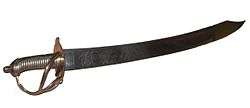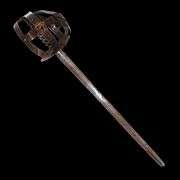Cutlass

A cutlass is a short, broad sabre or slashing sword, with a straight or slightly curved blade sharpened on the cutting edge, and a hilt often featuring a solid cupped or basket-shaped guard. It was a common naval weapon during the Age of Sail.
Etymology
The word cutlass developed from a 17th-century English variation of coutelas, a 16th-century French word for a machete-like blade (the modern French for "knife", in general, is "couteau"; the word was often spelled "cuttoe" in 17th and 18th century English). The French word is itself a corruption of the Italian coltellaccio, or "large knife", a short, broad-bladed sabre popular in Italy during the 16th century[1] The word comes from coltello, "knife", derived ultimately from Latin cultellus meaning "small knife."[2]
In the English-speaking Caribbean, the term "cutlass" is used as a word for machete.[3][4]
History and use
.jpg)
Origin
The cutlass is a 17th-century descendent of the edged short sword exemplified by the medieval falchion.
Woodsmen and soldiers in the 17th and 18th centuries used a similar short and broad backsword called a hanger, or in German a messer, meaning "knife". Often occurring with the full tang more typical of knives than swords in Europe, which is commonly believed to reflect a legal claim to nonweapon status, these blades may ultimately derive through the falchion (facon, falcon) from the seax.
In times of peace the Ottoman Empire supplied no arms, and the Janissaries on service in the capital of Constantinople were armed only with clubs; they were forbidden to carry any arms save a cutlass, known as a yatagan.[1]
History
Although also used on land, the cutlass is best known as the sailor's weapon of choice. A naval side-arm, its popularity was likely because it was not only robust enough to hack through heavy ropes, canvas, and wood, but short enough to use in relatively close quarters, such as during boarding actions, in the rigging, or below decks. Another advantage to the cutlass was its simplicity of use. Employing it effectively required less training than that required to master a rapier or small sword, and it was more effective as a close-combat weapon than a full-sized sword would be on a cramped ship.
Cutlasses are famous for being used by pirates, although there is no reason to believe that Caribbean buccaneers invented them, as has sometimes been claimed.[5] However, the subsequent use of cutlasses by pirates is well documented in contemporary sources, notably by the pirate crews of William Fly, William Kidd, and Stede Bonnet. French historian Alexandre Exquemelin reports the buccaneer Francois l'Ollonais using a cutlass as early as 1667. Pirates used these weapons for intimidation as much as for combat, often needing no more than to grip their hilts to induce a crew to surrender, or beating captives with the flat of the blade to force their compliance or responsiveness to interrogation.[6][7][8][9]
Owing to its versatility, the cutlass was as often an agricultural implement and tool as it was as a weapon (cf. machete, to which the same comment applies), being used commonly in rain forest and sugarcane areas, such as the Caribbean and Central America. In their most simplified form they are held to have become the machete of the Caribbean.
| Late naval examples | ||||||
|---|---|---|---|---|---|---|
|
Modern history
In 1936 the British Royal Navy announced that from then on cutlasses would be carried only for ceremonial duties and not used in landing parties.[10] The last recorded use of cutlasses by the Royal Navy is often said to be on 16 February 1940 during the boarding action known as the Altmark Incident. However, this is disbelieved by the majority of the HMS Cossack Association (Cossack was the ship that boarded Altmark) and the authors of British Naval Swords and Swordmanship. The authors point to another claim, a boarding by HMS Armada in 1952, but disbelieve this one too. In their view, the last use of cutlasses by the Royal Navy was by a shore party in China in 1900.[11] Cutlasses continue to be worn in the Royal Navy by a Chief Petty Officer escorting the White Ensign and by Senior or Leading Ratings in an escort at a court martial.[12]
The cutlass remained an official weapon in United States Navy stores until 1949, though seldom used in training after the early 1930s. The last new model of cutlass adopted by the U.S. Navy was the Model 1917; although cutlasses made during World War II were called the Model 1941, they were only a slightly modified variant of the Model 1917.[13] A United States Marine Corps engineer NCO is reported to have killed an enemy with a Model 1941 cutlass at Incheon during the Korean War.[14] A cutlass is still carried by the recruit designated as the Recruit Chief Petty Officer for each training company unit of recruits while at the US Navy Recruit Training Command. In a message released March 31, 2010, the US Navy approved optional wear of a ceremonial cutlass as part of the Chief Petty Officer dress uniform, pending final design approval.[15] That approval came in January 2011, and the cutlass was made available for ceremonial wear by Chief Petty Officers in August of that year.[16]
See also
Sources and references
 This article incorporates text from a publication now in the public domain: Chisholm, Hugh, ed. (1911). "article name needed". Encyclopædia Britannica (11th ed.). Cambridge University Press.
This article incorporates text from a publication now in the public domain: Chisholm, Hugh, ed. (1911). "article name needed". Encyclopædia Britannica (11th ed.). Cambridge University Press.
References
- 1 2 Ossian, Rob, The Cutlass (accessed Jan. 25, 2015)
- ↑ http://www.etymonline.com/index.php?term=cutlass
- ↑ John Klein, "What Is a Machete, Anyway?", "The Atlantic, Oct 21, 2013 (accessed Jan 25 2015)
- ↑ Teresa P Blair, A-Z of Jamaican Patois (Patwah), Page 49 Google Books Result
- ↑ "Pirate Weapons". Brethren of the Coast. Archived from the original on 2007-12-23. Retrieved 2009-03-30.
According to legend, buccaneers invented the cutlass, but this may not be factual. It is said to have evolved from the long knives used by the early buccaneers to butcher their meat.
- ↑ Lawson, John Davis (1915). American State Trials. St. Louis: F.H. Thomas Law Book Co. p. 668.
But as soon as they came up the shrouds, they clapped all hands to their cutlasses. Then I saw we were taken...
- ↑ John Richard Stephens, ed. (2006). Captured by Pirates. New York City: Barnes & Noble. p. 6. ISBN 0-7607-8537-6.
They immediately drew their weapons and, after beating us up severely with their cutlasses, drove us below.
- ↑ John Richard Stephens, ed. (2006). Captured by Pirates. New York City: Barnes & Noble. p. 9. ISBN 0-7607-8537-6.
[N]ine or ten men of a most ferocious aspect armed with muskets, knives, and cutlasses . . .ordered Captain Cowper, Mr. Lumsden, the ship's carpenter, and myself to go on board the pirate, hastening our departure by repeated blows with the flat part of their cutlasses over our backs.
- ↑ John Richard Stephens, ed. (2006). Captured by Pirates. New York City: Barnes & Noble. p. 40. ISBN 0-7607-8537-6.
[T]he man who gave the order commenced beating me severely with the broad side of his cutlass.
- ↑ "Royal Navy". Official Appointments and Notices. The Times (47514). London. 1936-10-24. col D, p. 17.
- ↑ Mark Barton, John McGrath, British Naval Swords and Swordmanship, p. 21, Seaforth Publishers, 2013 ISBN 184832135X.
- ↑ "RN DRESS TABLES (39A-2)" (PDF). www.royalnavy.mod.uk. Royal Navy Digital. October 2013. Retrieved 26 March 2014.
- ↑ Wagner, Rick. "Focus on the M1917/M1941 Cutlass". The Swordcollector. Retrieved 2008-09-19.
- ↑ Gilkerson, Bill (1991). Boarders Away. Volume 1: With Steel. Lincoln, Rhode Island: Andrew Mowbray Inc. ISBN 978-0-917218-50-7.
- ↑ Press release (2010-03-31). Uniform Changes Include CPO Cutlass, Ball Caps. United States Navy. Retrieved 2011-01-11.
- ↑ Press release (2011-01-25). NAVADMIN 025/11 - Uniform Board Update. United States Navy. Retrieved 2012-03-18.
_cutlass_drill.jpg)

